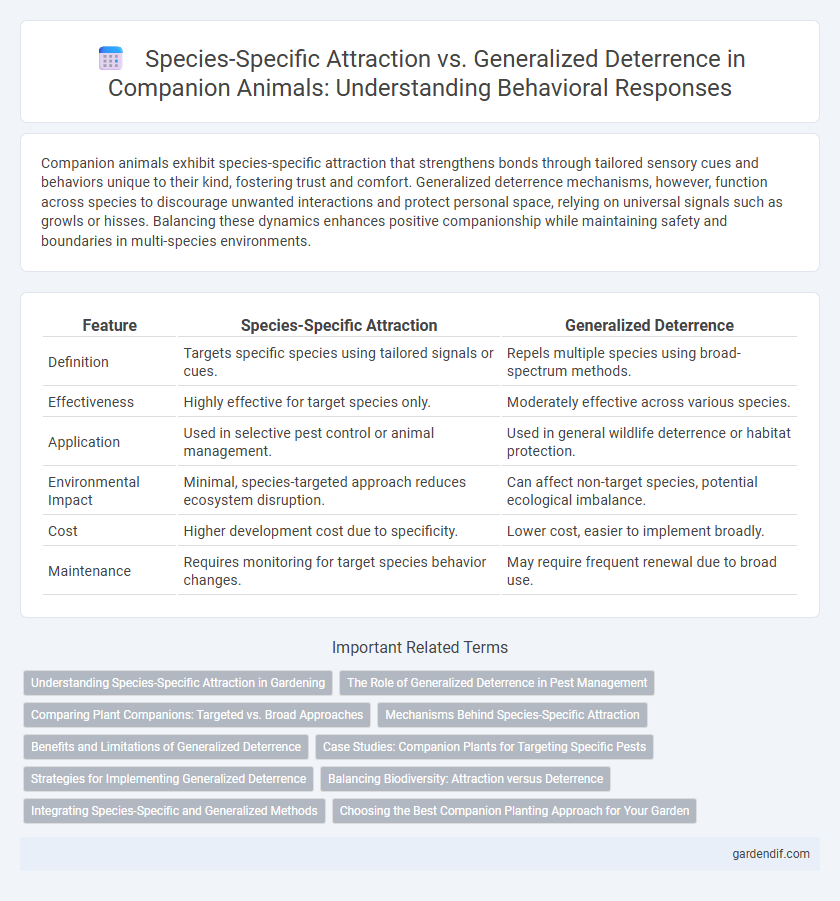
Species-specific attraction vs generalized deterrence Illustration
Companion animals exhibit species-specific attraction that strengthens bonds through tailored sensory cues and behaviors unique to their kind, fostering trust and comfort. Generalized deterrence mechanisms, however, function across species to discourage unwanted interactions and protect personal space, relying on universal signals such as growls or hisses. Balancing these dynamics enhances positive companionship while maintaining safety and boundaries in multi-species environments.
Table of Comparison
| Feature | Species-Specific Attraction | Generalized Deterrence |
|---|---|---|
| Definition | Targets specific species using tailored signals or cues. | Repels multiple species using broad-spectrum methods. |
| Effectiveness | Highly effective for target species only. | Moderately effective across various species. |
| Application | Used in selective pest control or animal management. | Used in general wildlife deterrence or habitat protection. |
| Environmental Impact | Minimal, species-targeted approach reduces ecosystem disruption. | Can affect non-target species, potential ecological imbalance. |
| Cost | Higher development cost due to specificity. | Lower cost, easier to implement broadly. |
| Maintenance | Requires monitoring for target species behavior changes. | May require frequent renewal due to broad use. |
Understanding Species-Specific Attraction in Gardening
Species-specific attraction in gardening involves using plants that uniquely appeal to certain companion species, enhancing beneficial interactions such as pollination and pest control. This targeted approach contrasts with generalized deterrence methods that repel a broad range of pests, offering a more precise and sustainable way to maintain garden health. Understanding these species-specific relationships allows gardeners to create balanced ecosystems that promote plant growth and biodiversity.
The Role of Generalized Deterrence in Pest Management
Generalized deterrence plays a critical role in pest management by exploiting broad-spectrum signals that discourage a wide array of pest species from damaging crops or companion plants. Unlike species-specific attraction, which targets individual pests with particular cues, generalized deterrence leverages common behavioral or sensory aversions, enhancing the efficiency of integrated pest management strategies. This approach reduces pest populations sustainably, minimizing reliance on chemical pesticides and promoting ecological balance in agricultural systems.
Comparing Plant Companions: Targeted vs. Broad Approaches
Species-specific attraction in companion planting leverages precise biochemical signals to draw beneficial organisms that enhance growth or pest resistance of particular plants. Broad-spectrum deterrence employs generalized traits, such as strong odors or toxic compounds, to repel a wide range of pests across multiple species. Comparing these approaches reveals targeted companions offer optimized support for individual plants, whereas generalized deterrents provide versatile protection in diverse garden ecosystems.
Mechanisms Behind Species-Specific Attraction
Species-specific attraction in companion animals is driven primarily by unique olfactory cues and pheromones that target neural pathways associated with social bonding and reproduction. These chemical signals enable precise recognition and foster selective behaviors, enhancing species-appropriate interaction and reducing cross-species conflicts. Understanding these mechanisms aids in developing targeted pheromone therapies and behavior-modification strategies tailored to specific companion animal species.
Benefits and Limitations of Generalized Deterrence
Generalized deterrence in companion species offers broad protection by reducing the risk of multiple threats through non-specific behavioral cues or signals. Its benefits include enhanced safety from diverse predators and decreased reliance on identifying exact threats, making it efficient for species with limited cognitive recognition abilities. However, limitations arise as generalized deterrence may lead to unnecessary energy expenditure and reduced foraging efficiency due to false alarms and lack of precise threat discrimination.
Case Studies: Companion Plants for Targeting Specific Pests
Case studies on companion plants reveal species-specific attraction effectively targets pests by utilizing plants that emit volatile organic compounds tailored to attract pest predators or repel target pest species. For example, marigolds (Tagetes spp.) specifically deter nematodes and whiteflies in tomato crops, while basil (Ocimum basilicum) attracts beneficial insects such as hoverflies to manage aphid populations. These targeted interactions optimize pest control by enhancing natural predator presence rather than employing generalized deterrent methods, which often lack precision and efficacy.
Strategies for Implementing Generalized Deterrence
Strategies for implementing generalized deterrence in companion species involve leveraging multisensory stimuli that broadly discourage unwanted behaviors regardless of species-specific preferences. Techniques such as high-frequency sounds, bitter taste additives, and motion-activated deterrents create an aversive environment, reducing interactions without relying on targeted attraction cues. This approach enhances effectiveness across diverse companion animals by minimizing species-specific variations in response patterns.
Balancing Biodiversity: Attraction versus Deterrence
Species-specific attraction targets particular companion species to enhance ecological interactions, promoting biodiversity by ensuring the presence of beneficial pollinators or predators. Generalized deterrence, by contrast, reduces threats broadly, minimizing damage from pests or invasive species without targeting a single species. Balancing these strategies supports sustainable ecosystems, optimizing both attraction of positive species and deterrence of harmful ones to maintain biodiversity.
Integrating Species-Specific and Generalized Methods
Integrating species-specific attraction with generalized deterrence enhances companion animal management by targeting particular behavioral cues while maintaining broad environmental controls. Species-specific methods leverage unique olfactory, auditory, or visual stimuli to attract or repel target species effectively, increasing precision in behavior modification. Combining these tailored approaches with generalized deterrents creates a synergistic effect that improves overall efficacy in managing companion animal interactions and reducing unwanted behaviors.
Choosing the Best Companion Planting Approach for Your Garden
Selecting the optimal companion planting strategy hinges on understanding species-specific attraction, where certain plants draw beneficial insects or repel pests unique to particular crops. Generalized deterrence involves using plants with broad-spectrum pest-repellent properties that protect multiple species within the garden ecosystem. Evaluating the targeted pest pressure and plant compatibility ensures the best approach enhances growth, reduces chemical use, and promotes biodiversity.
Species-specific attraction vs generalized deterrence Infographic

 gardendif.com
gardendif.com